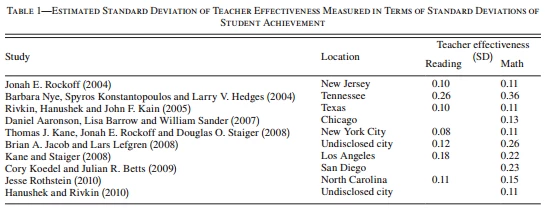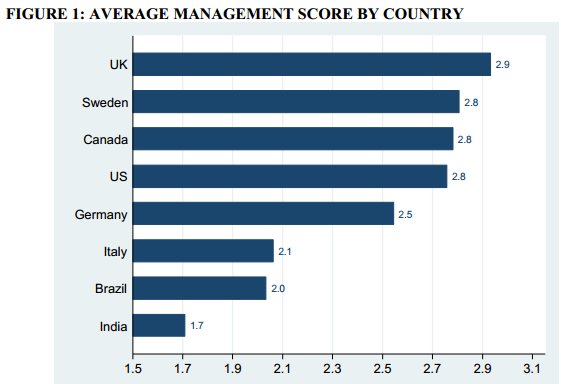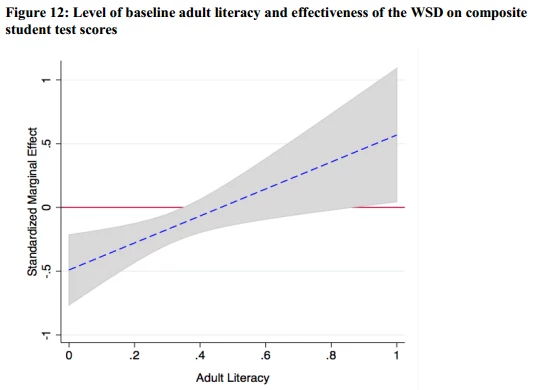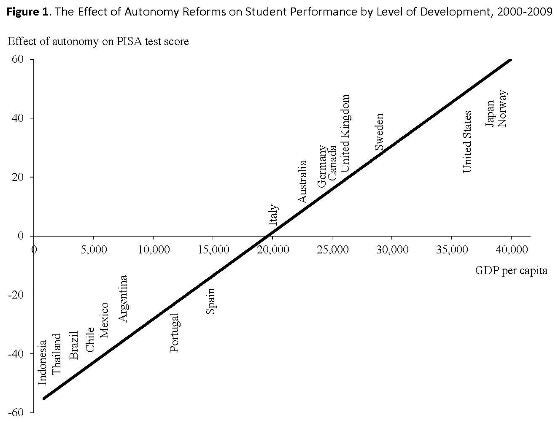This blog post is co-authored with
Moussa P. Blimpo
and Nathalie Lahire.
School Management Matters
Recent test score data has highlighted the crucial role of teachers in education. A series of studies (summarized by Hanushek & Rivkin in the table below), demonstrates that better teachers have big impacts on student performance. This is consistent with – for example – evidence from Chile that better evaluated teachers have better student results, and evidence from Mexico City ( p. 109 in Bruns & Luque 2014) that shows better student results for teachers with better classroom management.

Source: Hanushek & Rivkin 2010
Beyond the classroom, does school management matter? Last year, Bloom et al. released the results of a massive data collection exercise, surveying 1,800 schools across 8 countries: the Brazil, Canada, Germany, India, Italy, Sweden, the UK, and the US. They gathered data using an instrument of open-ended questions to measure four broad areas of school management. We provide a simplified description below:
Across countries, the differences are stark, as you can see in the figure below. (That’s an average score across the 20 total management questions.) Furthermore, the management score correlates positively and significantly with student test scores, controlling for a variety of factors. (The correlation is highly significant for the pooled sample and for Brazil and for India separately.)
Of course, these shouldn’t be interpreted causally, but to us, they suggest that there is value in exploring school management more.

Source: Bloom et al. 2014
Trying to Change It in The Gambia
In a recent intervention, the government of The Gambia sought to change school management as a way to improving teaching and learning in the classroom. (We’ve just released a paper on it.) The program was called Whole School Development, or WSD. In it, school principals, teachers, and members of the community all participated in a comprehensive school management training program. The program covered six areas: (1) community participation, (2) learner’s welfare and the school environment, (3) curriculum management, (4) teaching and learning resources, (5) teachers’ professional development, and (6) leadership and management. The training lasted between 10 and 20 days, much of it in local language and using drawings to reach non-literate parent participants.
School committees (including the principal, teachers, and parents) were then encouraged to design a school development plan. They received a one-time $500 grant to jumpstart implementation.
In order to evaluate the effectiveness of the program, we worked with the government to randomly assign each of 273 schools into one of three groups: (A) Whole School Development (with a grant), (B) Grant only, and (C) control schools. Comparing WSD to the Grant-only group tells us whether the training did anything, separate from the money. We then followed these schools over four years.
The WSD decreased both student and teacher absenteeism, and it improved at least some measures of teacher practice (teachers calling on students by name, for example). But those intermediate improvements weren’t sufficient to translate into higher average test scores. One possible explanation for that is that the program attracted lower performing students who weren’t enrolled at the beginning of the project to enroll in school; we used Lee’s trimming procedure to check for this and didn’t find any evidence that it’s driving the results.
The grant alone had no impact on either absenteeism or test scores. (The grant did increase parent’s reported involvement in school decision making, however, so apparently they did meet to figure out how to spend the money!)
The Role of Parental Human Capital
If you’re asking parents to get more involved in the management of the school, it likely matters how much human capital the parents themselves have. So we interacted parental literacy (at the district level, which is the level for which it was available), with the two treatments to see if it mattered. It did! The WSD program interacted with adult literacy had a positive, significant impact on student test scores for both math and English. (Still no impact for the grant; sorry, grant!) You can see the relationship in the figure below. When parents have higher human capital, they can more effectively help in school management.

Source: Blimpo, Evans, & Lahire 2015
Before we get too excited (and we’re pretty excited), what else could parent literacy be a proxy for? It could be a stand-in for socio-economic status: Richer children have more literate parents and also have access to other resources. But when we interact socio-economic status – measured two different ways, through student interviews and through district-level census data – with the program, the effect is insignificant. What if adult literacy is a proxy for baseline ability of the students? We interact the program variable with baseline student test scores and find no effect.
So, while we can’t rule out every possibility, this evidence strongly suggests that getting the communities involved in managing the school will only be effective at improving student learning if the parents have a critical level of human capital. And while other forms of school management may have improved as a result of the program (through the principal and the teachers, as observed in improved teaching and reduced absenteeism), these weren’t sufficient by themselves to improve student learning.
These results are consistent with recent cross-country evidence showing that increased school autonomy is associated with higher student test scores in higher income environments but lower test scores in lower income environments.

Source: Hanushek & Rivkin 2013
School management matters. But to change it, the agents have to be able to access the training they’re receiving and have the skills and support to put it into action.
Bonus reading
School Management Matters
Recent test score data has highlighted the crucial role of teachers in education. A series of studies (summarized by Hanushek & Rivkin in the table below), demonstrates that better teachers have big impacts on student performance. This is consistent with – for example – evidence from Chile that better evaluated teachers have better student results, and evidence from Mexico City ( p. 109 in Bruns & Luque 2014) that shows better student results for teachers with better classroom management.

Source: Hanushek & Rivkin 2010
Beyond the classroom, does school management matter? Last year, Bloom et al. released the results of a massive data collection exercise, surveying 1,800 schools across 8 countries: the Brazil, Canada, Germany, India, Italy, Sweden, the UK, and the US. They gathered data using an instrument of open-ended questions to measure four broad areas of school management. We provide a simplified description below:
- Operations: Are there “meaningful processes that allow pupils to learn over time”? Are there teaching methods that can allow all pupils to achieve learning objectives? Does the school uses assessment to verify learning?
- Monitoring: Is the school’s performance measured, reviewed, communicated to staff, and acted on?
- Target setting: Do school, individual, and department targets align? Does the school have targets tied to pupil outcomes? Are those targets sufficiently difficult to achieve?
- People / talent management: Is good teacher performance rewarded? Does the school have a way to deal with underperformers? How does the school manage and retain teachers?
Across countries, the differences are stark, as you can see in the figure below. (That’s an average score across the 20 total management questions.) Furthermore, the management score correlates positively and significantly with student test scores, controlling for a variety of factors. (The correlation is highly significant for the pooled sample and for Brazil and for India separately.)
Of course, these shouldn’t be interpreted causally, but to us, they suggest that there is value in exploring school management more.

Source: Bloom et al. 2014
Trying to Change It in The Gambia
In a recent intervention, the government of The Gambia sought to change school management as a way to improving teaching and learning in the classroom. (We’ve just released a paper on it.) The program was called Whole School Development, or WSD. In it, school principals, teachers, and members of the community all participated in a comprehensive school management training program. The program covered six areas: (1) community participation, (2) learner’s welfare and the school environment, (3) curriculum management, (4) teaching and learning resources, (5) teachers’ professional development, and (6) leadership and management. The training lasted between 10 and 20 days, much of it in local language and using drawings to reach non-literate parent participants.
School committees (including the principal, teachers, and parents) were then encouraged to design a school development plan. They received a one-time $500 grant to jumpstart implementation.
In order to evaluate the effectiveness of the program, we worked with the government to randomly assign each of 273 schools into one of three groups: (A) Whole School Development (with a grant), (B) Grant only, and (C) control schools. Comparing WSD to the Grant-only group tells us whether the training did anything, separate from the money. We then followed these schools over four years.
The WSD decreased both student and teacher absenteeism, and it improved at least some measures of teacher practice (teachers calling on students by name, for example). But those intermediate improvements weren’t sufficient to translate into higher average test scores. One possible explanation for that is that the program attracted lower performing students who weren’t enrolled at the beginning of the project to enroll in school; we used Lee’s trimming procedure to check for this and didn’t find any evidence that it’s driving the results.
The grant alone had no impact on either absenteeism or test scores. (The grant did increase parent’s reported involvement in school decision making, however, so apparently they did meet to figure out how to spend the money!)
The Role of Parental Human Capital
If you’re asking parents to get more involved in the management of the school, it likely matters how much human capital the parents themselves have. So we interacted parental literacy (at the district level, which is the level for which it was available), with the two treatments to see if it mattered. It did! The WSD program interacted with adult literacy had a positive, significant impact on student test scores for both math and English. (Still no impact for the grant; sorry, grant!) You can see the relationship in the figure below. When parents have higher human capital, they can more effectively help in school management.

Source: Blimpo, Evans, & Lahire 2015
Before we get too excited (and we’re pretty excited), what else could parent literacy be a proxy for? It could be a stand-in for socio-economic status: Richer children have more literate parents and also have access to other resources. But when we interact socio-economic status – measured two different ways, through student interviews and through district-level census data – with the program, the effect is insignificant. What if adult literacy is a proxy for baseline ability of the students? We interact the program variable with baseline student test scores and find no effect.
So, while we can’t rule out every possibility, this evidence strongly suggests that getting the communities involved in managing the school will only be effective at improving student learning if the parents have a critical level of human capital. And while other forms of school management may have improved as a result of the program (through the principal and the teachers, as observed in improved teaching and reduced absenteeism), these weren’t sufficient by themselves to improve student learning.
These results are consistent with recent cross-country evidence showing that increased school autonomy is associated with higher student test scores in higher income environments but lower test scores in lower income environments.

Source: Hanushek & Rivkin 2013
School management matters. But to change it, the agents have to be able to access the training they’re receiving and have the skills and support to put it into action.
Bonus reading
- Of course, one component of this program in The Gambia was a school grant, with little apparent effect. Evaluations of two other school grant programs have recently been released. In Senegal, school grants were effective when funds were focused on teaching and management rather than school materials. In Indonesia, researchers showed that low-intensity ways of informing parents about the grants didn’t boost parent engagement, but higher intensity ways (holding a meeting or sending a targeted text messages) did.
- How much do teachers matter for student learning? How much does school management matter? How much do school grants matter? If you want a fuller summary, you can always turn to this review of the research. Or this one. Or this one. Or this one. Or this one. Or this one. Or this one. Or a summary of them all. Or just read a couple of hundred studies yourself.
- If this isn’t enough education research on The Gambia for you, there’s much more. In 2007, The Gambia was the site of one of the early implementations of the Early Grade Reading Assessment. In 2014, a paper came out measuring the impact of the teacher hardship allowance (it worked to increase the qualified teachers in hardship districts, not at the expense of non-hardship districts). And for everything you’d want to know about the Gambian education system, it’s all here in a pithy 270 pages. There are ongoing evaluations on improving early reading in the early grades and teaching physics and math in the upper grades. More results coming soon!


Join the Conversation